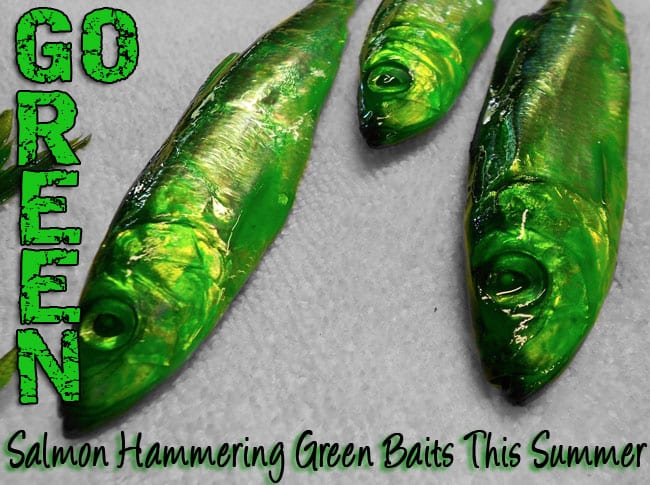Spawn
Go Green! Salmon hammering green baits this summer.
By Duane Inglin | 08/17/2012
In the last few months I’ve fielded many questions from fellow anglers spending time in The Bait Lab. One of the most common revolves around turning baits green. I’ve been going green a lot this season, but unfortunately you can’t buy green Nectar or Fire Brine. Pautzke doesn’t make those colors. Going green requires a little work. Rest assured, though, creating green herring is easier than you’d expect. It doesn’t take a Mixologist to do so.
The green craze has evolved over the past few years. Historically, we’ve had good success on chartreuse herring and anchovies. Knowing that, I really wanted to fish green herring. I knew by simply mixing blue and chartreuse Fire Brine I could create green. I just wasn’t sure on the ratios. Fortunately, I did my homework in The Bait Lab and figured it out.
I’ve conducted many experiments in the last few months and believe that exact measurements aren’t vital when it comes to getting the green color we all want. It’s more important to mix blue and green until you achieve the exact color you’re looking for. Through trial and error I learned that I could create several shades of green depending upon the amount of blue and chartreuse used. Nonetheless, I always start with chartreuse in the bag (or container) and watch the color change by slowing adding blue. Doing so allows me to get any darkness of green I want.

There are many different ratios that work, however, for this blog I wanted to provide many points of reference, which should aid your efforts to create green herring/alewives/sardines/anchovies.
Here’s my published study:
The following are the four comparisons. All four containers started with ½ bottle of chartreuse Fire Brine. I left some herring chartreuse so we have a base comparison (C). The three levels of green created were as follows.
G-1: ½ bottle chartreuse Fire Brine, 2 tbl sp. blue Fire Brine
G-2: ½ bottle chartreuse Fire Brine, 4 tbl sp. blue Fire Brine
G-3: ½ bottle chartreuse Fire Brine, 2 tbl sp. blue Nectar

After a 20-hour soak time I compared the darkness of green achieved.

When I compare the different shades of green the color I’ve seen the most success with is G-1.



When compared closely it’s apparent: the more blue added the bluer the herring is. On the other hand, if you are wondering how adding the blue may affect the UV the results are positive. The UV properties in chartreuse Fire Brine are so strong that it maintains the UV level regardless of how green you make the herring.

Here’s a recap of what I do to make the perfect green:
I start by filling a gallon Ziploc bag with a ½ to full bottle of chartreuse Fire Brine. Then, it’s time to blend chartreuse and blue Fire Brine. After pouring them in the bag, add the herring and let it sit for 18-24 hours. Sometimes I add 1 teaspoon of Fire Power (krill powder) for additional scent.
Bonus Plan: Adding Bite Stimulants To The Brine
If I plan on adding Nectar to my Fire Brine as a scent additive/bite stimulant on my herring, I can also use that as my color change. Pour chartreuse Fire Brine into the Ziploc and add the blue Nectar to achieve green. Keep in mind that the dye properties in the blue Nectar are every bit as strong as the Fire Brine. So your ratio may be the same, more or less, based on the previous information.
Give this a try and “Go Green” I think you will like the results.

Pautzke pro staffer Duane Inglin runs Strong Arm Guide Service in Washington. He’s also the co-host of
The Outdoor Line, a Seattle based fishing radio show heard of ESPN 710 Saturday mornings from 6-8 a.m.






